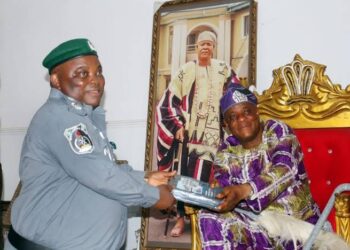As a final build-up to the delivery and installation of assets under the Deep Blue Project designed to secure Nigerian waters up to the Gulf of Guinea, the Director General of the Nigerian Maritime Administration and Safety Agency (NIMASA), Dr. Bashir Jamoh, in company with Minister of State for Petroleum Resources, Chief Timipre Sylva, and NIMASA’s Executive Director, Finance and Administration, Mr. Chudi Offodile on Wednesday received one of the Special Mission Aircraft for the exercise.
In a statement issued on Thursday and signed by NIMASA’s Head, Corporate Communications; Mr Philip Kyanet, the NIMASA DG had earlier inspected three Special Mission Helicopters at the Naval Base, Apapa, under the project billed for launch on May 21.
Addressing journalists at the Nigerian Air Force Base, Murtala Muhammed International Airport, Ikeja, during a brief ceremony to mark the arrival of the aircraft, Jamoh said the assets would further improve security in Nigerian waters.
The Director General assured of a drastic reduction in the rate of attacks in the country’s Exclusive Economic Zone (EEZ) with the deployment of the Deep Blue Project assets, saying the goal is to completely eliminate such incidents.
He said, “There has been a drastic decrease in the rate of security breaches in our waters in recent times. This is a clear indication that we are getting it right with the Deep Blue Project.
“The figures we are getting from the International Maritime Bureau (IMB) are encouraging. We ultimately aim to completely eradicate security hindrances to shipping and business generally in the Nigerian maritime domain.”
Recall that, the International Maritime Bureau (IMB), a specialised division of the International Chamber of Commerce (ICC), focusing on maritime crimes and malpractices has in recent months reported a consistent year-on-year drop in the number of attacks on ships in Nigerian waters.
The latest IMB quarterly report of piracy and armed robbery against ships recorded only two incidents in Nigerian waters between January and March this year, compared to 11 attacks within the same period last year.
“These figures are a proof that we can make our waters safe and secure, and we are determined to do so,” Jamoh stated. “Today, we are here to receive the final phase of assets under the Deep Blue Project to further boost our capacity to secure our waters up to the Gulf of Guinea,” he added.
The Integrated National Security and Waterways Protection Infrastructure, popularly called the Deep Blue Project, is designed with three categories of platforms to tackle maritime security issues on land, sea, and air.
The land assets comprise the Command, Control, Communication, Computer, and Intelligence Centre (C4i) for intelligence gathering and data collection; 16 armoured vehicles for coastal patrol; and about 600 specially trained troops for interdiction, known as Maritime Security Unit. On air, there are two Special Mission Aircraft for surveillance of the EEZ, one of which was received Wednesday, with the second expected to arrive May 18; three Special Mission Helicopters for search and rescue; and four Unmanned Aerial Vehicles. The sea assets consist of two Special Mission Vessels and 17 Fast Interceptor Boats.
















Discussion about this post